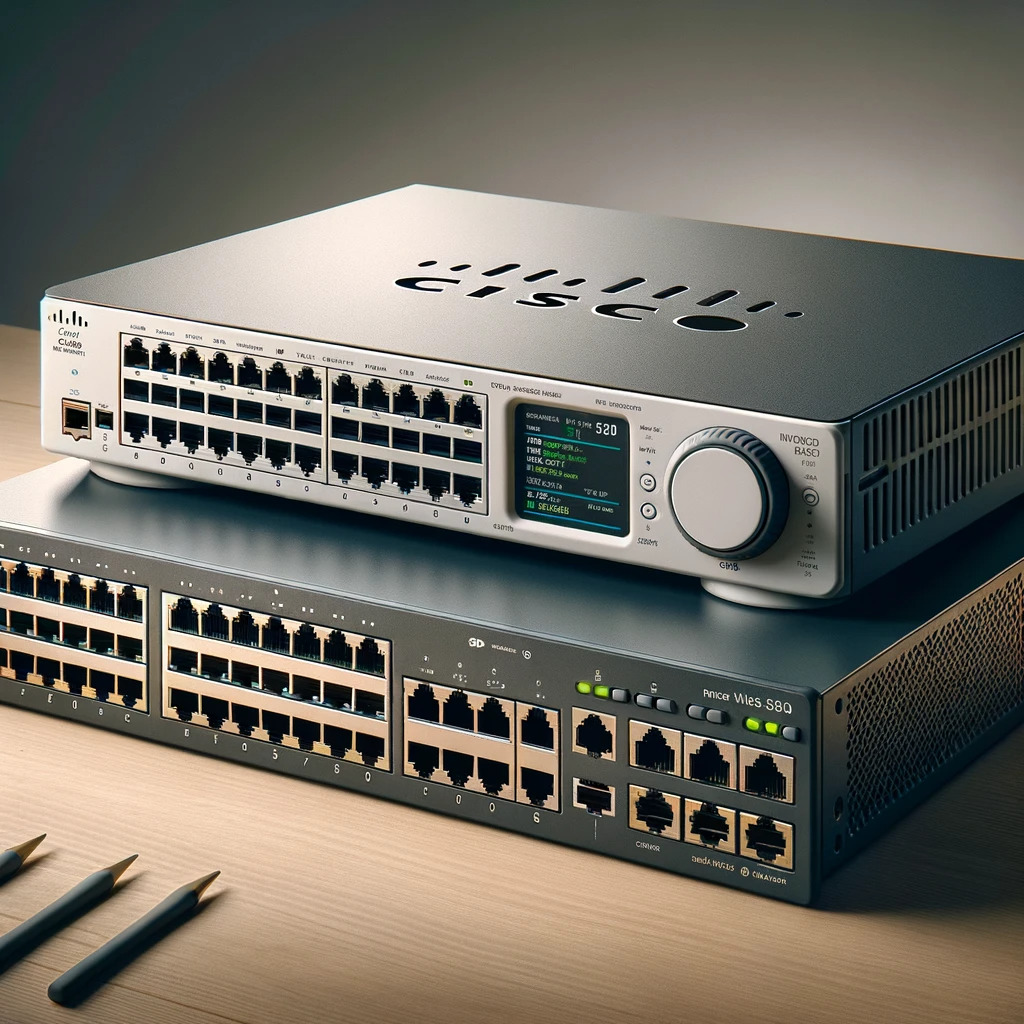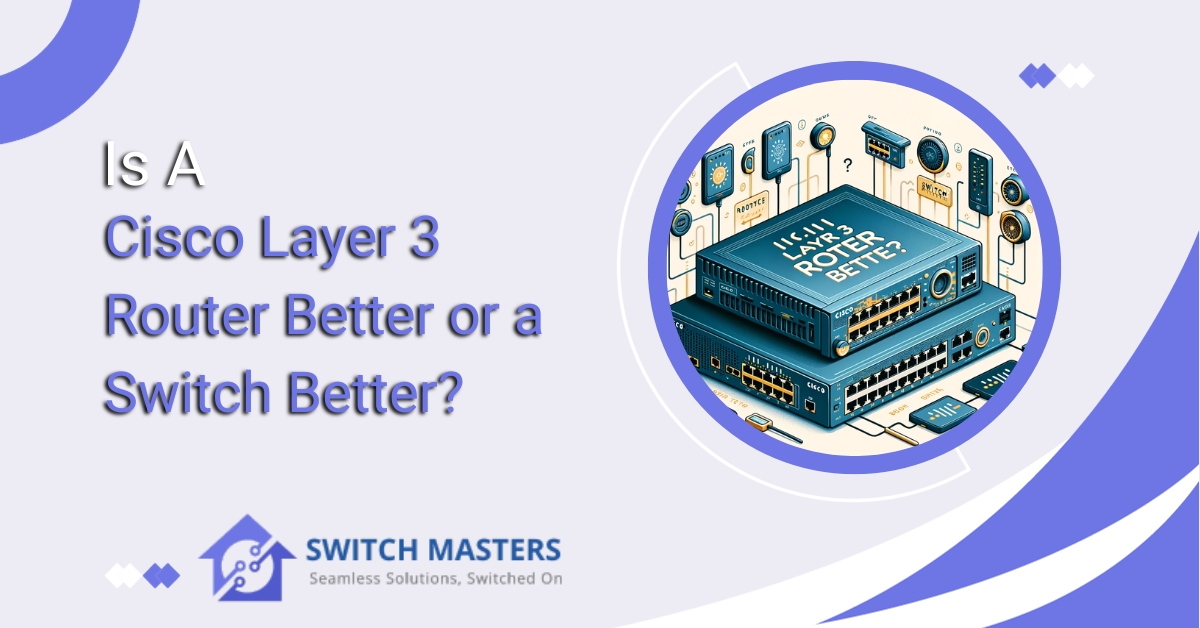Discover the ultimate guide for Is a Cisco Layer 3 Router Better or a Switch Better? Explore whether a Cisco Layer 3 router or switch is better for your specific needs. Make the right decision for seamless connectivity and efficiency.
Introduction
In the ever-changing landscape of networks, the choice between a Layer 3 Cisco router and switch is a critical decision. Each option offers unique capabilities and advantages, making it essential to understand the differences and determine which aligns best with your specific network requirements. Let’s delve into this decision-making process to ensure you choose the right option for your network infrastructure.
Understanding Routers
Routers are fundamental components in the world of networks, playing a crucial role in directing data packets through the complex network of interconnected devices and networks. Let’s dive into what routers are and why they are indispensable for efficient data transmission.
What is a Router?
At its core, a router is a network device designed to connect different networks together. It acts as a central hub, directing data traffic between devices within a local network (LAN) and beyond, to other networks like the Internet. Routers are equipped with several key functionalities that make them vital for modern networks:
- Packet Forwarding: Routers analyze data packets and determine the most efficient route for them to reach their destination. This process ensures that data is delivered accurately and quickly.
- Network Address Translation (NAT): NAT is a technique used by routers to map multiple private IP addresses within a LAN to a single public IP address. This allows multiple devices in a local network to share a single Internet connection.
- Security: Routers often include built-in firewalls and security features, protecting the local network against unauthorized access and external threats.
When to Use a Router
Routers are the preferred choice in various situations, including:
- Home Networks: If you want to connect multiple devices like smartphones, laptops, smart TVs, and gaming consoles to the Internet, a router is the ideal choice.
- Small Businesses: Routers are suitable for small business networks, where they can manage network traffic, provide Internet access, and offer basic security features.
- Network Segmentation: Routers are used to divide a large network into smaller segments, improving traffic management and security.
In summary, routers are the key pieces of modern networks, ensuring that data reaches its intended destination efficiently and securely. Understanding their capabilities is essential for building and maintaining robust network infrastructures.
Unpacking Cisco Layer 3 Switches
Cisco Layer 3 switches, also known as multilayer switches, represent a powerful fusion of traditional network switches and routers. These devices offer unique capabilities that are essential in today’s complex network environments. Let’s delve into what Cisco Layer 3 switches are and why they are becoming increasingly indispensable.

The Essence of Cisco Layer 3 Switches
Cisco Layer 3 switches are advanced networking devices that combine the high-speed data processing capabilities of traditional switches with the intelligence and routing capabilities of routers. They operate at the network layer (Layer 3) of the OSI model, hence the name “Layer 3 switches.”
Here are some key features and functions that stand out in Cisco Layer 3 switches:
- VLAN Routing: Layer 3 switches enable traffic routing between different Virtual Local Area Networks (VLANs) within a network. This is a significant advantage for network segmentation and efficient traffic management.
- Fast Packet Forwarding: These switches excel in packet forwarding, thanks to their high processing capacity. This ensures that data packets are quickly and accurately directed to their intended destinations.
- Enhanced Security: Cisco Layer 3 switches often come equipped with advanced security features, making them the ideal choice for protecting sensitive data in enterprise networks.
Ideal Scenarios for Cisco Layer 3 Switches
Cisco Layer 3 switches shine in various network environments, such as:
- Enterprise Networks: Large organizations benefit from the scalability, performance, and routing capabilities of Cisco Layer 3 switches for managing complex network infrastructures.
- Virtualization Environments: In virtualized data centres, Layer 3 switches are used to efficiently route traffic between virtual machines (VMs) in different VLANs.
- High-Traffic Networks: These switches are suitable for networks with high volumes of data traffic, where fast packet processing and routing are essential.
Cisco Layer 3 switches offer the best of both worlds: the speed of switches and the intelligence of routers. Their ability to handle complex routing tasks while maintaining high-speed data forwarding makes them a valuable asset in many network scenarios. Understanding their capabilities is crucial for making informed decisions in network design and management.
Factors to Consider
When it comes to choosing between a Layer 3 router and a Cisco Layer 3 switch for your network, several critical factors come into play. Making the right decision depends on a thorough evaluation of these elements. Let’s explore the key considerations that will guide you in making an informed choice.
1. Size and Complexity of the Network
The size and complexity of your network play a significant role in determining the most suitable option.
- Routers: They are suitable for smaller networks with simple routing needs, such as home networks or small businesses.
- Cisco Layer 3 Switches: In larger and more complex networks, especially in enterprise environments where network segmentation and efficient traffic management are essential, Cisco Layer 3 switches are often the best choice.
2. Routing Requirements
Consider the scope of routing needed in your network.
- Routers: If your network primarily involves routing data between different networks or connecting to the internet, a router is the logical choice.
- Cisco Layer 3 Switches: These switches excel in routing between VLANs within a network. If your network requires routing internal traffic between different segments, they are a solid option.
3. Budgetary Constraints
Budgetary constraints are always a critical factor in any decision.
- Routers: Routers are typically more budget-friendly, making them a practical choice for small-scale networks.
- Cisco Layer 3 Switches: These switches are feature-rich and consequently may be more expensive. They are often a better option for organizations with larger budgets or more extensive network needs.
4. Scalability
Consider whether your network needs room to grow.
- Routers: Routers may be limited in terms of scalability, especially for larger networks. Expansion may involve additional routing equipment.
- Cisco Layer 3 Switches: These switches are typically more scalable, making them a smart choice for networks with growth potential.
5. Security Requirements
Security is paramount in today’s network landscape.
- Routers: Routers often come with built-in security features and firewalls, making them a suitable choice for networks with strict security needs.
- Cisco Layer 3 Switches: These switches also offer robust security features but are typically used in environments where internal traffic segmentation is a security requirement.
The decision between a router and a Cisco Layer 3 switch is not one-size-fits-all. The right choice depends on the specific needs of your network, its size, budget, and security considerations. Carefully evaluating these factors will help you make an informed decision that ensures optimal performance and efficiency in your network.
Applications in the Real World
Understanding the practical applications of Layer 3 Cisco routers and switches is crucial for making an informed decision for your network. Let’s explore real-world scenarios where each of these network devices shines.

Routers
- Home Networks: Routers serve as the backbone of most home networks. They efficiently manage the connection of various devices like smartphones, laptops, smart TVs, and gaming consoles to the Internet. Their user-friendly interface, affordability, and basic security features make them the preferred choice for households.
- Small Businesses: Small businesses often rely on routers for their networking needs. Routers can handle the traffic generated by a modest number of users and provide Internet access, making them a cost-effective solution for new businesses and small offices.
- Network Segmentation: In scenarios where network segmentation is not a primary concern, routers are an excellent choice. They effectively route data between different networks, making them suitable for simple network setups.
Layer 3 Cisco Switches
- Enterprise Networks: In large-scale enterprises where network complexity is high, Layer 3 Cisco switches excel. They stand out in VLAN routing, enabling efficient traffic management and secure data transmission. These switches are crucial for managing extensive networks with numerous departments and diverse security needs.
- Data Centers: Data centres, especially in virtualized environments, benefit from the capabilities of Layer 3 Cisco switches. These switches can efficiently route between virtual machines (VMs) in different VLANs, ensuring fast data transfers and low latency, which are critical for data centre operations.
- High-Traffic Networks: Networks with intensive data traffic, such as Internet Service Providers (ISPs) or large-scale e-commerce platforms, require swift packet forwarding and sophisticated routing. Layer 3 Cisco switches can handle these demands with ease, ensuring seamless data transmission and minimal congestion.
Layer 3 Cisco routers and switches find their niches in various real-world applications. Routers are the preferred choice for simpler networks like homes and small businesses, while Layer 3 Cisco switches are invaluable in enterprise settings, data centres, and high-traffic environments. Understanding these practical applications is key to making the right decision for your specific networking needs.
Is a Cisco Layer 3 Router Better or a Switch Better?: Making the Right Decision
Choosing between a Layer 3 router and a Cisco switch is a crucial decision that will significantly impact the performance, efficiency, and scalability of your network. To ensure you make the right decision, follow these key steps:
1. Assess your network needs
Begin by conducting a thorough assessment of your network requirements. Consider the size of your network, its complexity, and the specific tasks you need to perform. Understanding your network’s needs is the foundation for making an informed decision.
2. Define your budget
Determine the limitations of your budget. Routers are typically more budget-friendly, while Cisco Layer 3 switches tend to be feature-rich but come at a higher cost. Make sure your choice aligns with your financial resources.
3. Consider future growth
Think about the future. Will your network need to expand or become more complex? If scalability is a concern, a Cisco Layer 3 switch might be a wiser choice, as it can adapt to network growth more effectively.
4. Evaluate security requirements
Security is a fundamental concern in the modern networking landscape. Evaluate the security needs of your network. Both routers and Cisco Layer 3 switches offer security features, but Cisco switches are often chosen for networks with strict security requirements.
5. Examine network segmentation
Network segmentation, especially in larger organizations, can be essential. If your network requires dividing traffic into different segments, Cisco Layer 3 switches are suitable for this purpose.
6. Seek expert advice
If you’re unsure which option is best for your network, consider consulting with networking professionals or experts. They can provide valuable insights based on your unique circumstances.
7. Test and Adapt
Sometimes, the best way to determine the ideal choice is through practical testing. If possible, conduct tests in your specific network environment to evaluate the performance of routers and Cisco Layer 3 switches. This hands-on experience can be invaluable for making the right decision.
FAQ’s
Is a Cisco Layer 3 switch more expensive than a router?
Cisco Layer 3 switches are usually more costly than traditional routers due to their advanced capabilities. However, their cost is justified in scenarios that require their features.
Can a router handle network segmentation?
Routers can handle network segmentation to a certain extent, but Cisco Layer 3 switches are better equipped for this task, especially in larger networks.
Are Cisco Layer 3 switches more secure than routers?
Both devices offer security features, but Cisco Layer 3 switches are often preferred in environments with higher security requirements.
In what scenarios are routers the best choice?
Routers are an excellent choice for home networks, small businesses, and simple network setups that do not require complex routing.
What are the main benefits of inter-VLAN routing using Cisco Layer 3 switches?
Inter-VLAN routing allows for efficient traffic management, enhanced security, and network segmentation in larger networks.
How can I determine the right choice for my network?
Evaluate the size of your network, its complexity, your budget, and your security needs. Seek expert advice if necessary and conduct practical tests to make an informed decision.
Conclusion
In the realm of networking, the choice between a router and a Cisco Layer 3 switch is not a one-size-fits-all decision. It requires a careful evaluation of the specific needs of your network and an understanding of the capabilities of each device. By following the guidelines in this guide, you can make an informed decision that ensures optimal performance and efficiency in your network.















